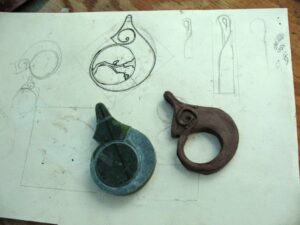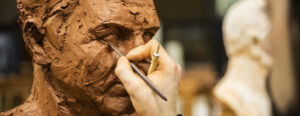
The tall block of Yule marble balances on the dunnage and stares back with white intensity. A nervous knot of anxiety rolls through the stomach. Point away the loose and irregular material. Anticipate the genius within. No arm reaches out to pull away the veil. This bedded block of stark white and precision frames what? There is no preconceived motif. Move around the 600 pound piece of stone and sketch the fleeting images that flirt with consciousness. All work stops to attend a mandatory group lecture.
It’s the first day of the third session of MARBLE/marble 13. After the preliminaries, instructor Scott Owens provokes some laughter as he dramatically emphasizes the importance of a maquette for sculpting. He outlines a procedure using clay to form a shape proportional to the marble block. Use a knife or wire scoop to reductively model the form. This maquette will then lead the dance with diamond blade and chisel around the marble block. The mandate is proclaimed: each sculptor should have a maquette before carving stone!
Returning to the worksite with provocation and method, clay is molded with hands and fingers into a form proportional to the block. Move around the stone. See and transfer flaws and surface modulations to the clay. The process achieves a clay miniature of the marble block and enhances awareness of bedding planes and spatial form. A general feeling of inner form emerges from the familiarity. This acquaintance is given form using a small curved blade. Give the stone constant reference. Stone centers and grounds awareness. The clay is a three-dimensional sketch held in the hands and viewed with advantage to all angles as the dialogue continues. When complete, set the clay aside. Wipe away the sweat of passion, pour down some liquids and refresh the body.
Take up another piece of clay and again go through the process. What was the energy that brought this particular stone into consciousness? What form was missed through avoidance or lack of awareness? When the dialogue finishes, set down the second clay sketch.
A third sketch attempts to bring form to the essence of the experience. What was this form before the dialogue? It becomes the maquette that choreographs the dance ahead. Now let the music play!
Tools help us open the stone and reach for the image. The best ones enable and enhance the creative process. This column endeavors to be a clearinghouse of tools. If you have questions or revelations, email to pcrit@snowcrest.net or snail mail to Dan Michael, 7211 Bayview Dr NE, Olympia, WA, 98506. Questions about use or selection of tools will be referred to a group of sculptors, manufacturers, distributors, and tradespersons who are familiar with the particular item. The column may also be the reflection and ranting of a sculptor entangled in the web of stone. You get the picture?



We need some kind of descriptive text here.